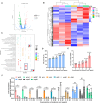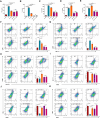Isoferulic acid facilitates effective clearance of hypervirulent Klebsiella pneumoniae through targeting capsule
- PMID: 39761301
- PMCID: PMC11737856
- DOI: 10.1371/journal.ppat.1012787
Isoferulic acid facilitates effective clearance of hypervirulent Klebsiella pneumoniae through targeting capsule
Abstract
Hypervirulent Klebsiella pneumoniae (hvKP) poses an alarming threat in clinical settings and global public health owing to its high pathogenicity, epidemic success and rapid development of drug resistance, especially the emergence of carbapenem-resistant lineages (CR-hvKP). With the decline of the "last resort" antibiotic class and the decreasing efficacy of first-line antibiotics, innovative alternative therapeutics are urgently needed. Capsule, an essential virulence determinant, is a major cause of the enhanced pathogenicity of hvKP and thus represents an attractive drug target to prevent the devastating clinical outcomes caused by hvKP infection. Here, we identified isoferulic acid (IFA), a natural phenolic acid compound widely present in traditional herbal medicines, as a potent broad-spectrum K. pneumoniae capsule inhibitor that suppresses capsule polysaccharide synthesis by increasing the energy status of bacteria. In this way, IFA remarkably reduced capsule thickness and impaired hypercapsule-associated hypermucoviscosity phenotype (HMV), thereby significantly sensitizing hvKP to complement-mediated bacterial killing and accelerating host cell adhesion and phagocytosis. Consequently, IFA facilitated effective bacterial clearance and thus remarkably protected mice from lethal hvKP infection, as evidenced by limited bacterial dissemination and a significant improvement in survival rate. In conclusion, this work promotes the development of a capsule-targeted alternative therapeutic strategy for the use of the promising candidate IFA as an intervention to curb hvKP infection, particularly drug-resistant cases.
Copyright: © 2025 Wang et al. This is an open access article distributed under the terms of the Creative Commons Attribution License, which permits unrestricted use, distribution, and reproduction in any medium, provided the original author and source are credited.
Conflict of interest statement
The authors have declared that no competing interests exist.
Figures








Similar articles
-
Emergence of hypervirulent and carbapenem-resistant Klebsiella pneumoniae from 2014 - 2021 in Central and Eastern China: a molecular, biological, and epidemiological study.BMC Microbiol. 2024 Nov 11;24(1):465. doi: 10.1186/s12866-024-03614-9. BMC Microbiol. 2024. PMID: 39528921 Free PMC article.
-
RfaH contributes to maximal colonization and full virulence of hypervirulent Klebsiella pneumoniae.Front Cell Infect Microbiol. 2024 Sep 17;14:1454373. doi: 10.3389/fcimb.2024.1454373. eCollection 2024. Front Cell Infect Microbiol. 2024. PMID: 39364146 Free PMC article.
-
Relationship between virulence and carbapenem resistance phenotype of Klebsiella pneumoniae from blood infection: identification of a carbapenem-resistant and hypervirulent strain.Zhejiang Da Xue Xue Bao Yi Xue Ban. 2024 Aug 25;53(4):490-497. doi: 10.3724/zdxbyxb-2024-0104. Zhejiang Da Xue Xue Bao Yi Xue Ban. 2024. PMID: 39183061 Free PMC article. Chinese, English.
-
Clinical and laboratory insights into the threat of hypervirulent Klebsiella pneumoniae.Int J Antimicrob Agents. 2024 Sep;64(3):107275. doi: 10.1016/j.ijantimicag.2024.107275. Epub 2024 Jul 14. Int J Antimicrob Agents. 2024. PMID: 39002700 Review.
-
Hypervirulent Klebsiella pneumoniae - clinical and molecular perspectives.J Intern Med. 2020 Mar;287(3):283-300. doi: 10.1111/joim.13007. Epub 2019 Nov 21. J Intern Med. 2020. PMID: 31677303 Free PMC article. Review.
References
-
- Flynn CE, Guarner J. Emerging Antimicrobial Resistance. Modern pathology: an official journal of the United States and Canadian Academy of Pathology, Inc. 2023;36(9):100249. - PubMed
MeSH terms
Substances
LinkOut - more resources
Full Text Sources
Medical

